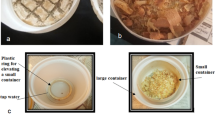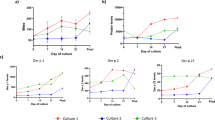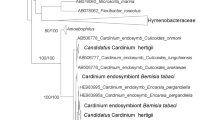Abstract
House dust mites are cultured to obtain mite allergen material to produce allergen extracts (vaccines) for diagnostic tests, immunotherapy, and research purposes. Research laboratories and manufacturers have their own culturing protocols to grow these mites and these may vary between manufacturers and between research laboratories. The temperature at which mites are cultured may influence the allergen composition, allergen ratio of Der 1: Der 2 and endotoxin levels in the extracts produced from these cultured mites. In order to produce standardized and uniform extracts, across the industry and in various research laboratories, the influence of culture conditions must be understood. Here we determined how temperature affects mite population growth rates, dynamics of allergen production, Der f 1: Der f 2 ratio and endotoxin levels in extracts made from Dermatophagoides farinae mites cultured at 20 and 25 °C. We found that Der f 1 and Der f 2 accumulated exponentially in the cultures with Der f 1 accumulating faster than Der f 2. When the live mite populations peaked, the ratios for Der f 1: Der f 2 were 4.1 and 4.7 for cultures reared at 20 and 25 °C, respectively. Most of the Der f 1 and Der f 2 allergen in whole cultures is not in mite bodies and is lost when the mite material is washed. Thus, if the ratio of Der f 1 and Der f 2 is an important consideration for commercial and research extracts, then the temperature at which the mites are cultured and the collection procedure are important considerations.



Similar content being viewed by others
References
Arbes SJ Jr, Gergen PJ, Elliott L, Zeldin DC (2005) Prevalences of positive skin test responses to 10 common allergens in the US population: results from the third National Health and Nutrition Examination Survey. J Allergy Clin Immunol 116:377–383
Arlian LG (1977) Humidity as a factor regulating feeding and water balance of the house dust mites Dermatophagoides farinae and D. pteronyssinus (Acari: Pyroglyphidae). J Med Entomol 14:484–488
Arlian LG, Dippold JS (1996) Development and fecundity of Dermatophagoides farinae (Acari: Pyroglyphidae). J Med Entomol 33:257–260
Arlian LG, Morgan MS (2003) Biology, ecology, and prevalence of dust mites. Immunol Allergy Clin North Am 23:443–468
Arlian LG, Brandt RL, Bernstein R (1978) Occurrence of house dust mites, Dermatophagoides spp. (Acari: Pyroglyphidae), during the heating season. J Med Entomol 15:35–42
Arlian LG, Bernstein IL, Gallagher JS (1982) The prevalence of house dust mites, Dermatophagoides spp., and associated environmental conditions in homes in Ohio. J Allergy Clin Immunol 69:527–532
Arlian LG, Bernstein IL, Geis DP, Vyszenski-Moher DL, Gallagher JS, Martin B (1987a) Investigations of culture medium-free house dust mites. III. Antigens and allergens of body and fecal extract of Dermatophagoides farinae. J Allergy Clin Immunol 79:457–466
Arlian LG, Bernstein IL, Vyszenski-Moher DL, Gallagher JS (1987b) Antigenicity and allergenicity of body and fecal extracts of the mite Dermatophagoides pteronyssinus (Acari: Pyroglyphidae). J Med Entomol 24:252–259
Arlian LG, Rapp CM, Ahmed SG (1990) Development of Dermatophagoides pteronyssinus (Acari: Pyroglyphidae). J Med Entomol 27:1035–1040
Arlian LG, Bernstein D, Bernstein IL, Friedman S, Grant A, Lieberman P, Lopez M, Metzger J, Platts-Mills T, Schatz M (1992) Prevalence of dust mites in the homes of people with asthma living in eight different geographic areas of the United States. J Allergy Clin Immunol 90:292–300
Arlian LG, Rapp CM, Fernandez-Caldas E (1993) Allergenicity of Euroglyphus maynei and its cross-reactivity with Dermatophagoides species. J Allergy Clin Immunol 91:1051–1058
Arlian LG, Confer PD, Rapp CM, Vyszenski-Moher DL, Chang JC (1998a) Population dynamics of the house dust mites Dermatophagoides farinae, D. pteronyssinus, and Euroglyphus maynei (Acari: Pyroglyphidae) at specific relative humidities. J Med Entomol 35:46–53
Arlian LG, Neal JS, Bacon SW (1998b) Survival, fecundity, and development of Dermatophagoides farinae (Acari: Pyroglyphidae) at fluctuating relative humidity. J Med Entomol 35:962–966
Avula-Poola S, Morgan MS, Arlian LG (2012) Diet influences growth rates and allergen and endotoxin contents of cultured Dermatophagoides farinae and D. pteronyssinus house dust mites. Int Arch Allergy Immunol 159:226–234
Brunetto B, Tinghino R, Braschi MC, Antonicelli L, Pini C, Iacovacci P (2010) Characterization and comparison of commercially available mite extracts for in vivo diagnosis. Allergy 65:184–190
Burazer L, Milovanovic K, Milovanovic M, Vuckovic O, Velickovic TC, Gavrovic-Jankulovic M (2011) Impact of Dermatophagoides pteronyssinus mite body raw material on house dust mite allergy diagnosis in a Serbian population. Med Vet Entomol 25:77–83
Casset A, Mari A, Purohit A, Resch Y, Weghofer M, Ferrara R, Thomas WR, Alessandri C, Chen KW, de Blay F, Valenta R, Vrtala S (2012) Varying allergen composition and content affects the in vivo allergenic activity of commercial Dermatophagoides pteronyssinus extracts. Int Arch Allergy Immunol 159:253–262
Chapman MD, Pomes A, Breiteneder H, Ferreira F (2007) Nomenclature and structural biology of allergens. J Allergy Clin Immunol 119:414–420
Colloff M (2009) Dust Mites. Springer, Dordrecht and CSIRO Publishing, Melbourne
Fernandez-Caldas E (2013) Towards a more complete standardization of mite allergen extracts. Int Arch Allergy Immunol 160:1–3
Hart BJ, Crowther D, Wilkinson T, Biddulph P, Ucci M, Pretlove S, Ridley I, Oreszczyn T (2007) Reproduction and development of laboratory and wild house dust mites (Acari: Pyroglyphidae) and their relationship to the natural dust ecosystem. J Med Entomol 44:568–574
Moyer DB, Nelson HS, Arlian LG (1985) House dust mites in Colorado. Ann Allergy 55:680–682
Park JW, Kim KS, Jin HS, Kim CW, Kang DB, Choi SY, Yong TS, Oh SH, Hong CS (2002) Der p 2 isoallergens have different allergenicity, and quantification with 2-site ELISA using monoclonal antibodies is influenced by the isoallergens. Clin Exp Allergy 32:1042–1047
Piboonpocanun S, Malainual N, Jirapongsananuruk O, Vichyanond P, Thomas WR (2006) Genetic polymorphisms of major house dust mite allergens. Clin Exp Allergy 36:510–516
Post S, Nawijn MC, Hackett TL, Baranowska M, Gras R, van Oosterhout AJ, Heijink IH (2012) The composition of house dust mite is critical for mucosal barrier dysfunction and allergic sensitisation. Thorax 67:488–495
Taketomi EA, Silva DA, Sopelete MC, Gervasio AM, Alves R, Sung SJ (2006) Differential IgE reactivity to Der p 1 and Der p 2 allergens of Dermatophagoides pteronyssinus in mite-sensitized patients. J Investig Allergol Clin Immunol 16:104–109
Thomas WR (2010) Geography of house dust mite allergens. Asian Pac J Allergy Immunol 28:211–224
Thomas WR, Smith WA, Hales BJ, Mills KL, O’Brien RM (2002) Characterization and immunobiology of house dust mite allergens. Int Arch Allergy Immunol 129:1–18
Thomas WR, Heinrich TK, Smith WA, Hales BJ (2007) Pyroglyphid house dust mite allergens. Protein Pept Lett 14:943–953
Valerio CR, Murray P, Arlian LG, Slater JE (2005) Bacterial 16S ribosomal DNA in house dust mite cultures. J Allergy Clin Immunol 116:1296–1300
Yella L, Morgan MS, Arlian LG (2011) Population growth and allergen accumulation of Dermatophagoides pteronyssinus cultured at 20 and 25°C. Exp Appl Acarol 53:103–119
Author information
Authors and Affiliations
Corresponding author
Rights and permissions
About this article
Cite this article
Yella, L., Morgan, M.S. & Arlian, L.G. Population growth and allergen accumulation of Dermatophagoides farinae cultured at 20 and 25 °C. Exp Appl Acarol 60, 117–126 (2013). https://doi.org/10.1007/s10493-012-9626-x
Received:
Accepted:
Published:
Issue Date:
DOI: https://doi.org/10.1007/s10493-012-9626-x




